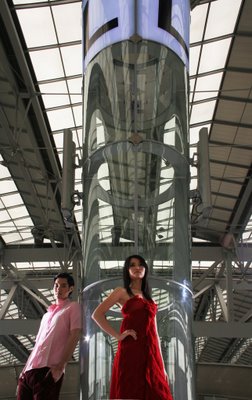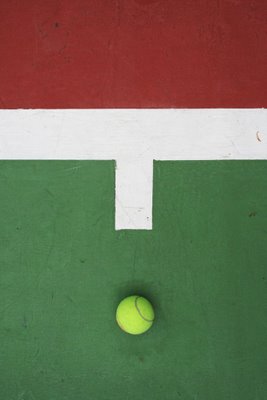Employee of the Month
Remember all those light tests? It was pretty boring stuff, right? Well the day has come when you can see what it was all about.








My boss was thrilled, my boss's boss was thrilled, everyone was thrilled and everyone told me that everyone was thrilled. These pictures were taken in one day and I had no assistant. There were 2 hairdressers and 2 makeup artists. There was an artistic director and a coordinator, there was an assistant stylist, there was a bunch of PRs from the Airport Authority of Thailand (this shoot is all about promoting Thailand's new airport opening next month), but no assistant photographer. I lugged around my four slave flashes, my tripods (2 nice ones and 2 of the kind you get free with some cameras), my white and transclucent future-board, my duct tape, my Vivitar 3200 flash and its silly mini-lightbox, etc. At one point I bumped into a photographer using a Mamiya RB67 and a digital back. Once I stopped drooling, I noticed he had two assistants. Then again, his tripod alone probably weighed as much as all my gear combined. Occasionaly, someone would pity me and help me carry some of my stuff. It was pretty insane come to think of it. We finished late but we finished. It was yesterday and I'm still tired.
If I saw this shoot in a magazine, I'd probably say it's utter crap and the photographer should be hanged and it's a bloody shame random assholes can pretend to be photographers and get away with it. In my defense, I wasn't anywhere near having full creative control on this thing and the models are not models but Suvarnabhumi airport's "ambassadors". But that's not even the point. I did it. It's mine. I worked hard to make sure it would at least be technically feasible and there were no bad surprises. Look at the light tests, it's more or less the same light as on these shoots. Oh and I even had one cool idea, putting flashes in the X-ray machine. I like that shot.








My boss was thrilled, my boss's boss was thrilled, everyone was thrilled and everyone told me that everyone was thrilled. These pictures were taken in one day and I had no assistant. There were 2 hairdressers and 2 makeup artists. There was an artistic director and a coordinator, there was an assistant stylist, there was a bunch of PRs from the Airport Authority of Thailand (this shoot is all about promoting Thailand's new airport opening next month), but no assistant photographer. I lugged around my four slave flashes, my tripods (2 nice ones and 2 of the kind you get free with some cameras), my white and transclucent future-board, my duct tape, my Vivitar 3200 flash and its silly mini-lightbox, etc. At one point I bumped into a photographer using a Mamiya RB67 and a digital back. Once I stopped drooling, I noticed he had two assistants. Then again, his tripod alone probably weighed as much as all my gear combined. Occasionaly, someone would pity me and help me carry some of my stuff. It was pretty insane come to think of it. We finished late but we finished. It was yesterday and I'm still tired.
If I saw this shoot in a magazine, I'd probably say it's utter crap and the photographer should be hanged and it's a bloody shame random assholes can pretend to be photographers and get away with it. In my defense, I wasn't anywhere near having full creative control on this thing and the models are not models but Suvarnabhumi airport's "ambassadors". But that's not even the point. I did it. It's mine. I worked hard to make sure it would at least be technically feasible and there were no bad surprises. Look at the light tests, it's more or less the same light as on these shoots. Oh and I even had one cool idea, putting flashes in the X-ray machine. I like that shot.















 That was pretty diplomatic. But it's not JPEG compression this pic is suffering from, it's from having been taken at 400 ASA with a compact Sony DSC-P200. I tried to reduce the noise in Photoshop but didn't do a very good job. There's so much of it! Now that I carry a tripod I shoot everything at 100 ASA.
That was pretty diplomatic. But it's not JPEG compression this pic is suffering from, it's from having been taken at 400 ASA with a compact Sony DSC-P200. I tried to reduce the noise in Photoshop but didn't do a very good job. There's so much of it! Now that I carry a tripod I shoot everything at 100 ASA.
 This image was shot at 100 ISO but underexposed. Raising the levels brought out the noise lurking in the shadows. This pic might be still be saved though with noise reduction or by resubmiting it at a smaller size. The best size to submit a pic on Istockphoto is 2560x1920 but the smallest acceptable size is 1600x1200 pixels. That means if your pic is rejected for questions of noise, or for a slight sharpness problem, you can make it smaller and see if that fixes the problem. You might miss out on some juicier deals but it's better than nothing. Large format downloads cost 5$ (which means $1 for you) but but also tend to be less frequent than the $1 800x600 websized download. 1600x1200 is $3. There's also XL size (4200x2800,$10) and XXL size (4900x3300,$20-40) but these would require stitching or VERY expensive cameras/digital backs.
This image was shot at 100 ISO but underexposed. Raising the levels brought out the noise lurking in the shadows. This pic might be still be saved though with noise reduction or by resubmiting it at a smaller size. The best size to submit a pic on Istockphoto is 2560x1920 but the smallest acceptable size is 1600x1200 pixels. That means if your pic is rejected for questions of noise, or for a slight sharpness problem, you can make it smaller and see if that fixes the problem. You might miss out on some juicier deals but it's better than nothing. Large format downloads cost 5$ (which means $1 for you) but but also tend to be less frequent than the $1 800x600 websized download. 1600x1200 is $3. There's also XL size (4200x2800,$10) and XXL size (4900x3300,$20-40) but these would require stitching or VERY expensive cameras/digital backs.





















 This is a durian, not to be confused with a jackfruit. It (like everything else in this post except the icecream) was shot with natural daylight bounced off white cardboard sheets that also doubled up as reflectors. The fruit is standing on a tube of glass that has been photoshopped out, so that light hits the bottom of fruit as well.
This is a durian, not to be confused with a jackfruit. It (like everything else in this post except the icecream) was shot with natural daylight bounced off white cardboard sheets that also doubled up as reflectors. The fruit is standing on a tube of glass that has been photoshopped out, so that light hits the bottom of fruit as well. Durian can be made into a paste and crushed almonds worked into the paste--delicious.
Durian can be made into a paste and crushed almonds worked into the paste--delicious. As these shots are for a catalogue, they are composed to go in the corner of a page that contains text. Hence, the image will only occupy a fraction of the page (1/3 or a 1/4). This shout would be the top right of a page, while the image above would be the bottom left of that same page.
As these shots are for a catalogue, they are composed to go in the corner of a page that contains text. Hence, the image will only occupy a fraction of the page (1/3 or a 1/4). This shout would be the top right of a page, while the image above would be the bottom left of that same page. The ice-cream couldn't be shot with natural light. I used flashes to allow a high enough shutter speed to freeze the dried durian flakes in mid-air. Of course, I used my slave flashes (see my previous posts, I've got 4 now). First I got a shot of the ice-cream with just the right amount of durian powder on it and then poured durian powder a dozen times until I got a good shot--which wasn't easy to time. Finally, I composited the spoon and falling powder with the ice-cream in photoshop. This way, I used only one ice-cream, and melting was not an issue.
The ice-cream couldn't be shot with natural light. I used flashes to allow a high enough shutter speed to freeze the dried durian flakes in mid-air. Of course, I used my slave flashes (see my previous posts, I've got 4 now). First I got a shot of the ice-cream with just the right amount of durian powder on it and then poured durian powder a dozen times until I got a good shot--which wasn't easy to time. Finally, I composited the spoon and falling powder with the ice-cream in photoshop. This way, I used only one ice-cream, and melting was not an issue. This is what the powder comes from, dried durian. It cooks in a pot underneath which is boiling oil. I believe that's as close to an oven as things get in Asia. The oil doesn't come in contact with the durian so it's a low-fat snack.
This is what the powder comes from, dried durian. It cooks in a pot underneath which is boiling oil. I believe that's as close to an oven as things get in Asia. The oil doesn't come in contact with the durian so it's a low-fat snack.
